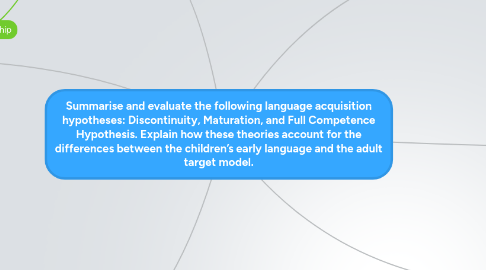Summarise and evaluate the following language acquisition hypotheses: Discontinuity, Maturation, and Full Competence Hypothesis. Explain how these theories account for the differences between the children’s early language and the adult target model.
by Graeme Small


1. adult target language
1.1. what is it?
1.2. scholar search
2. children's early language
2.1. what is it?
2.2. scholar search
2.3. stages of development from birth to infant
2.4. does it work in stages?
2.4.1. what proof is there?
3. Universal Grammar
3.1. nature nurture
3.2. encoded within genome?
3.3. No known “general learning mechanism” can acquire a natural language solely on the basis of positive or negative evidence, and the prospects for finding any such domain-independent device seem rather dim. The difficulty of this problem leads to the hypothesis that whatever system is responsible must be biased or constrained in certain ways. Such constraints have historically been termed “innate dispositions,” with those nderlying language referred to as “universal grammar.” Although these particular terms have been forcibly rejected by many researchers, and the nature of the particular constraints on human (or animal) learning mechanisms is currently unresolved, the existence of some such constraints cannot be seriously doubted
3.4. Chomsky
3.4.1. some scholars agree yet most seem to not
4. Discontinuity hypothesis
4.1. scholar search
4.2. work with Funmi and Christine
4.3. relationship between continuity and discontinuity
4.4. maturation hypothesis is linked
4.5. various stages of development from birth to infant
4.5.1. babbling
4.5.2. single words
4.5.3. two word utterence
4.5.4. grammatical sentence structure
4.5.4.1. early and simple
4.5.4.2. later and complex
5. Maturation hypothesis
5.1. scholar search
5.2. linked with discontinuity in that it helps explain the process of development of child language learning
6. Full competence hypthesis
6.1. scholar search
6.1.1. Maturation hypothesis
